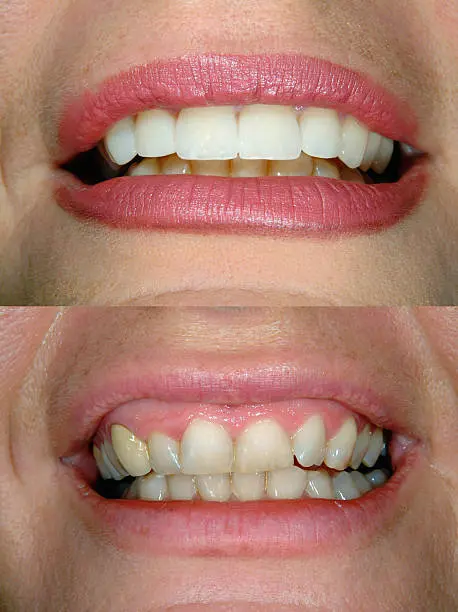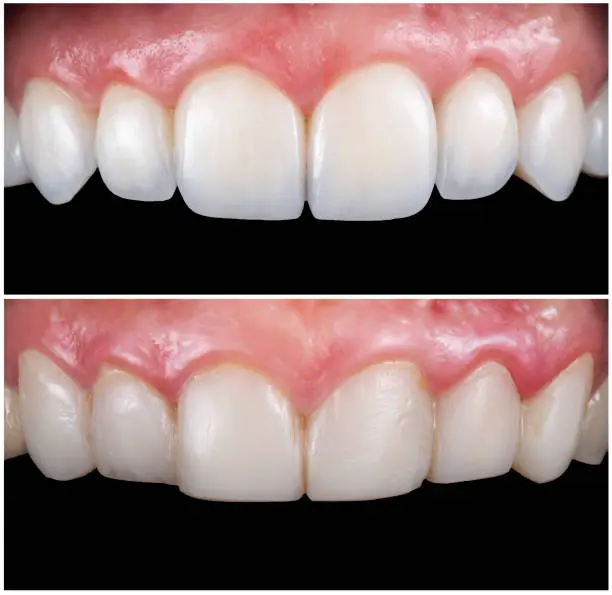Crown Lengthening
Crown lengthening is a surgical procedure that involves recontouring gum tissue to expose more of a tooth surface for a crown above the gumline. It's primarily used in cases where a tooth needs a restoration, such as a crown or bridge, but insufficient tooth structure is exposed above the gum line to support the restoration securely. This procedure can also be utilized for cosmetic reasons, improving the aesthetics of a "gummy" smile by exposing more of the teeth.
Gallery
Visual insights to help you understand what to expect from your treatment. For more content, please refer to our Education Hub.

Benefits & Considerations
Everything you need to know to make an informed decision about your treatment.
Benefits
Restorative Benefits
Crown lengthening is commonly used to prepare a tooth for further procedures such as the placement of a crown. If a tooth is broken below the gum line or does not have enough structure above the gum line to support a crown or bridge, crown lengthening can expose more of the tooth's surface to ensure a stable fit for the restoration.
Cosmetic Enhancements
For individuals with a "gummy" smile, where excessive gum tissue covers the teeth making them appear short, crown lengthening can balance the proportions of gums to teeth. This results in a more aesthetically pleasing smile.
Easier Oral Hygiene
By exposing more of the tooth and reducing deep gum pockets, crown lengthening can make it easier to clean teeth effectively. This can decrease the risk of periodontal disease or decay developing under poorly fitting crowns.
Prevents and Treats Dental Issues
Reduces tooth decay risk by reducing gum pockets and exposing more of the tooth, crown lengthening can help prevent tooth decay that commonly occurs under the gum line.
Long-Term Durability of Dental Restorations
Increases restoration longevity by allowing for better crown placement, crown lengthening can increase the longevity of dental restorations. Well-fitted crowns are less likely to fail because they have a solid foundation of tooth structure to adhere to.
Improved Fitting of Dental Applications
Aside from crowns, the procedure is beneficial for other dental prosthetics and can be vital for individual treatment plans involving orthodontics or bridges.
Considerations
Bleeding
Minor bleeding is normal during and after the procedure, but excessive bleeding can occur, particularly if the patient has a bleeding disorder or is taking blood-thinning medications.
Infection
As with any surgical procedure, there is a risk of infection at the site of the surgery. Proper post-operative care and hygiene are critical to minimizing this risk.
Swelling and Pain
Some amount of swelling and pain is expected after the surgery. These symptoms are usually manageable with medications prescribed by the dentist or surgeon but can occasionally be more severe than anticipated.
Gum Recession
Crown lengthening involves cutting away gum tissue, which can sometimes lead to unintended gum recession. This recession might expose more of the tooth root, which can increase sensitivity and vulnerability to decay or further gum disease.
Tooth Sensitivity
Exposing more of a tooth's root surface can lead to increased sensitivity, especially to hot, cold, or sweet foods and drinks. This sensitivity usually decreases over time but can be persistent in some cases.
Impacted Tooth Stability
Removing bone around a tooth can impact its stability, especially if a large amount of bone is removed.
Treatment Procedure
Let's walk through your treatment procedure from start to finish.
Consultation and Planning
Initial dental exams and X-rays are taken to plan the procedure. The dentist will discuss the goals and outline the approach.
Local Anaesthesia
Local anesthesia is administered to numb the area and ensure comfort during the procedure.
Surgical Process
The practitioner makes incisions to pull back the gums from the teeth, exposing the underlying bone and roots. Depending on the case, small amounts of bone might be removed to reshape the contour of the gum and bone levels around the teeth.
Laser technology, facilitated by our in-house Fotona Lightwalker can also be used for a minimally-invasive alternative.
Suturing
After achieving the desired reshaping, the gums are sutured back into place. In some cases, a bandage or dressing might be placed for additional protection.
Recovery
The healing phase typically lasts for several weeks to a few months, during which the revamped gum line must be kept clean and free from infection.
Post-Operative Care
Simple steps to protect your smile and ensure optimal results in the days following your procedure.
Pain Management
Over-the-counter pain relievers or prescribed medications can help manage discomfort.
Diet
Soft foods and lukewarm soups are recommended initially to avoid irritating the surgical site.
Oral Hygiene
Gentle brushing in non-operated areas is encouraged, whereas the treated site should be kept clean and undisturbed as much as possible.
Follow-up Visits
Regular check-ups with the periodontist to monitor healing and ensure that the gums are healing properly.
Avoid Grinding
If you grind or clench your teeth, you might be at risk of damaging your fillings as well as your natural teeth. Consider discussing with your dentist whether you need an occlusal splint/nightguard.

Crown lengthening can be a vital component of both restorative and cosmetic dental treatment plans. If you are considering this procedure, consulting with a skilled dentist who specialises in cosmetic procedures is essential to evaluate your specific needs and goals, ensuring you achieve optimal health and aesthetic results.